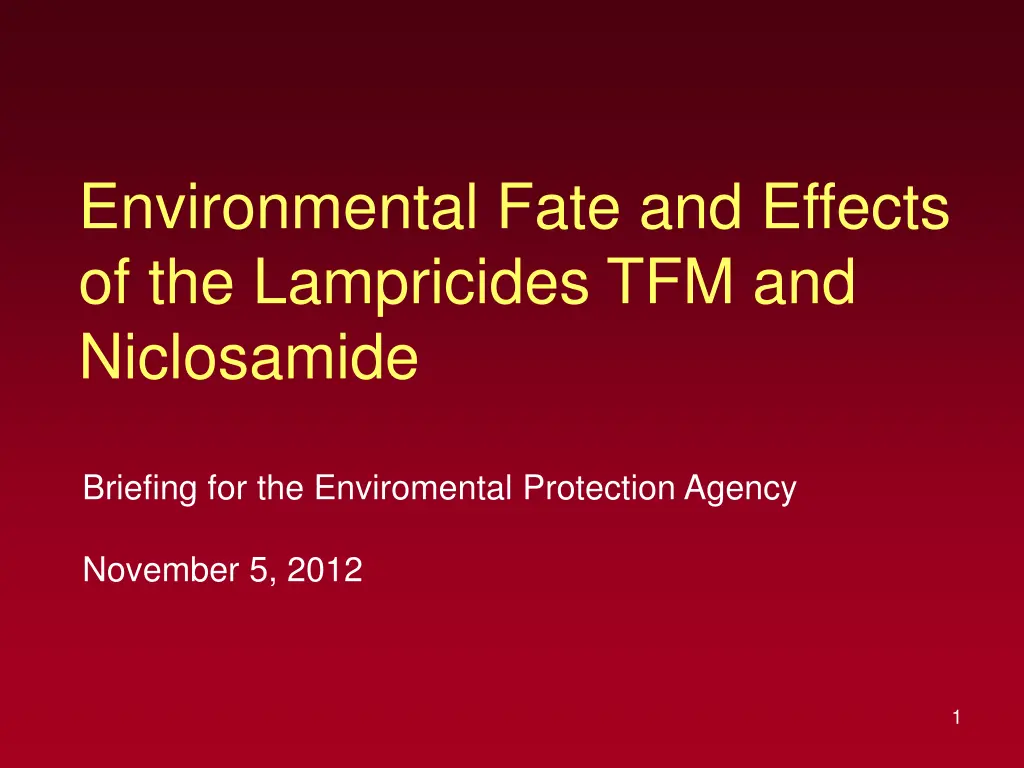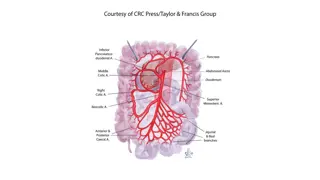
Environmental Fate & Effects of Lampricides TFM and Niclosamide
Learn about the environmental fate and effects of lampricides TFM and Niclosamide as presented in a briefing for the Environmental Protection Agency. The assessment covers human health risks, environmental impacts, photodegradation, hydrolysis, and binding to sediment. Find out about the low toxicity risks to human health, stable environmental fate with some impacts on aquatic organisms, and mitigation strategies. Additional studies on photodegradation and metabolism are also highlighted.
Download Presentation

Please find below an Image/Link to download the presentation.
The content on the website is provided AS IS for your information and personal use only. It may not be sold, licensed, or shared on other websites without obtaining consent from the author. If you encounter any issues during the download, it is possible that the publisher has removed the file from their server.
You are allowed to download the files provided on this website for personal or commercial use, subject to the condition that they are used lawfully. All files are the property of their respective owners.
The content on the website is provided AS IS for your information and personal use only. It may not be sold, licensed, or shared on other websites without obtaining consent from the author.
E N D
Presentation Transcript
Environmental Fate and Effects of the Lampricides TFM and Niclosamide Briefing for the Enviromental Protection Agency November 5, 2012 1
Lampricide Fate and Effects TFM Hubert, T. D. 2003. Environmental Fate and Effects of the Lampricide TFM: A Review. Journal of Great Lakes Research. 29(Supplement 1):456-474. Niclosamide Dawson, V. K. 2003. Environmental Fate and Effects of the Lampricide Bayluscide: A Review. 29(Supplement 1):475-492. 2
EPA Assessment Human Health Moderate to low toxicity Risk of exposure low No developmental toxicity No carcinogenicity No mutagenicity Conclusion No risk to general population 3
EPA Assessment Environmental Fate and Effects Chemically stable and persistent Some impacts to aquatic organisms Aquatic communities recover quickly Conclusions Risks reduced by Flushing action of stream Rapid repopulation from non-treated portions of stream Treatment on 3-5 year cycles 4
Additional studies TFM Photodegradation Niclosamide Photodegradation Aerobic aquatic metabolism Anaerobic aquatic metabolism 5
OH Cl Cl O C N NO2 CF3 H OH NO2 TFM Niclosamide 6
Environmental Fate - Hydrolysis TFM Resistant to hydrolysis Half-lives over 1400 days Niclosamide Resistant at basic pH Half-life at pH 5 120 hours 7
Photodegradation pH TFM t1/2 (h) 11.6 Niclosamide t1/2 (h) 7.2 5 7 9 4.15 3.36 11.7 30 8
Photodegradation Degradation products Low molecular weight organic acids Substituted 2, 3, and 4 carbon organic acids (maleic, oxalic, glyoxylic) Carbon dioxide 9
Binding to sediment Milakokia River 1997 Sandy sediment Chemical fell below detection in 24 to 96 hours Carp River and Fish Creek 2010 Slight organic content sediment Same result: below detection in 24 to 96 hours 10
Aerobic/anaerobic degradation TFM Half-lives 2 to 5 days RTFM, incorporation in high MW organic matter, polymers, humic or fulvic acids Niclosamide Half-lives ~ 5 days aerobically; 0.65 to 2.79 days anaerobically Small carbon compounds and incorporation into humin 11
Metabolism OGlu OH glucuronyl transferase CF3 CF3 NO2 NO2 12
Metabolism Aquatic Insects TFM: Sulfation, glucuronidation Niclosamide: hydrolysis, conjugation Fish TFM: glucuronidation Niclosamide: glucuronidation, sulfation Mammals TFM: glucuronidation, reduction and acetylation, sulfation Niclosamide: glucuronidation 13
Uptake and Elimination Species studied - green algae, aquatic plants, isopods (sowbug), amphipods, crayfish, mayfly, caddisfly, annelid worms (leeches), snails, fingernail clams, and fish Half-lives ranged from 7 hours to 18 days Exception: annelid worms, t1/2 = ~ 221 days Bioconcentration factors (BCF) for whole body and tissues ranged from less than 1 to ~ 62 Dioxin: BCF 5,840 in fathead minnow 14
Effects on Plants TFM Aquatic Plants Toxic at >15 mg/L Effects at 5 mg/L but plants recover Green Algae/Blue-green Algae Reduction in growth at < 10 mg/L Minor reductions in pH and dissolved oxygen Niclosamide No effects at treatment concentrations 15
Fish TFM Toxicity low to high depending on species Generally high margins of selectivity Niclosamide Highly toxic to most fish Margin of selectivity lower than TFM 16
American eel Tested elvers Highly resistant to TFM or TFM/niclosamide mixtures 4 to 7 times MLC for sea lamprey 17
Effects on Aquatic Invertebrates TFM Slightly to moderately toxic Niclosamide Slightly to highly toxic 18
Endangered Hungerfords crawling water beetle Surrogate Haliplus spp tested Adults and larvae Survival unaffected at up to 3.9X MLC Adults appeared to avoid chemical by crawling out of water 19
Mussels Giant floater, fragile papershell, pink heelsplitter, black sandshell, snuffbox, ellipse At concentrations of TFM required to kill lampreys mortality is minimal. Adults, juveniles, glochidia are resistant; recruitment not affected. TFM/1% niclosamide caused some mortality 20
Native lamprey study Lampetra, Ichthyomyzon, Petromyzon No significant difference in median lethal concentration Slight difference in MLC between Lampetra and Petromyzon Some lampetra will survive treatments Native lamprey will be impacted 21
Effects on Reptiles and Amphibians TFM Turtles No effects Frogs Effects that vary depending on species, stage of development, and route of exposure Mudpuppies Reports of sensitivity and population declines UMESC study adults not affected (2.4X MLC) Juveniles < 100 mm are less resistent to TFM (1.5X MLC) Juveniles more sensitive to TFM/niclosamide mixture Niclosamide Turtles No effects at treatment concentrations Frogs No effects at treatment concentrations 22
Effects on Birds TFM Oral toxicity ranged from 250 mg/kg to 546 mg/kg body weight Water concentrations of between 15 mg/L and 50 mg/L Uncoordination and lethargy depending on length of exposure Niclosamide Oral toxicity ranged from 500 mg/kg to over 2000 mg/kg Water concentration of 0.10 mg/L Produced slight uncoordination in one animal 23
Common tern St. Marys River Risk from eating dead larvae In lab exposed larvae to bayer granular and wettable powder Analyzed for niclosamide 3.49 ppb tissue concentration Low acute toxicity exposure risk 24
Piping plover Endangered Estimate exposure risk Residues in water and caged insects Likely exposure for adults 85X below NOEC Likely exposure for chicks 17X below NOEC 25
Effects on Mammals TFM Oral toxicity 141 to 387 mg/kg Dermal toxicity: > 2000 mg/kg Moderate dermal and eye irritation Niclosamide Oral toxicity >5000 mg/kg Dermal toxicity >2000 mg/kg Inhalation toxicity 1.95 mg/L Mild eye irritation, no dermal irritation 26
Effects on Mammals TFM No effects to decreased body weights, increased liver weights, and reduced weights in offspring No cancer, mutations, developmental toxicity or increased tumor incidence No reproductive effects Niclosamide No effects to decreased body weights, increased liver weights, and reduced weights in offspring No cancer, mutation, developmental toxicity, or increased tumor incidence Abnormal sperm morphology in mice 27
Summary Effects transient Do not persist Relatively non-toxic 28
Questions 29






















